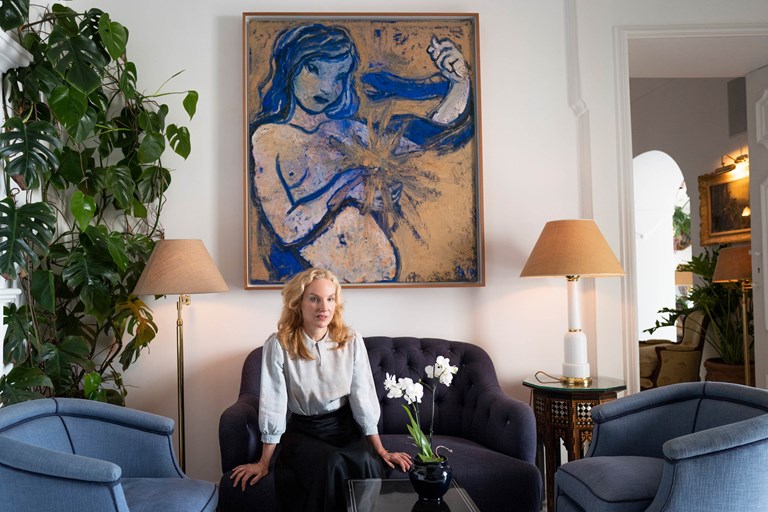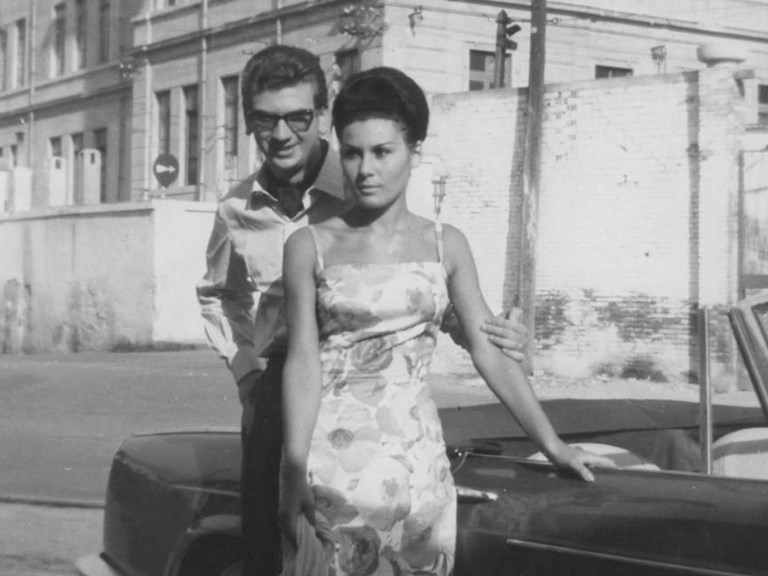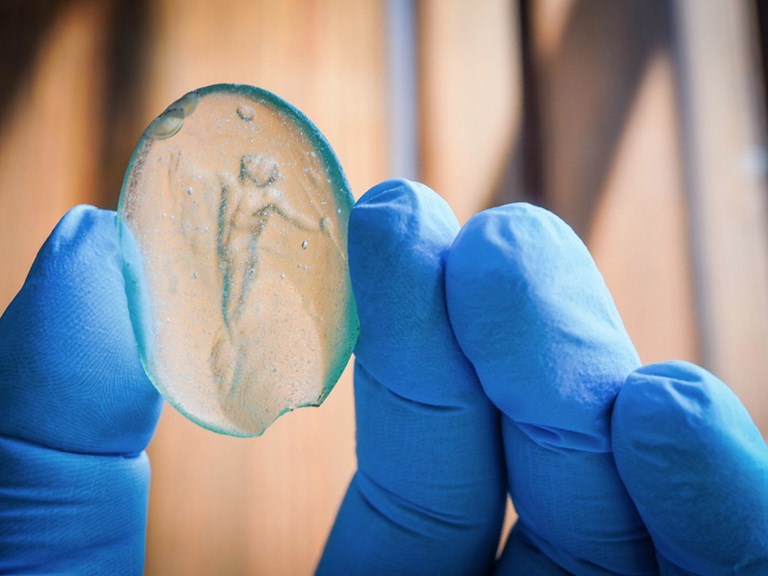ARTISTS AT LE SIRENUSE: RITA ACKERMANN
01.12.2019 ART & CULTURE
Working principally in paint and pigment, Ackermann builds erasure, blurring and overpainting into her artistic practice and the fabric of her works, evolving a personal mythology of signs and symbols that are transformed in and by the constructive, destructive creative moment. Represented by Hauser & Wirth, Ackermann has exhibited worldwide, with recent solo shows including ‘Brother and Sister’ at Hauser & Wirth Zürich and ‘Rita Ackermann: Movements as Monuments’ at La Triennale di Milano.
Commissioned by Antonio and Carla Sersale and curator Silka Rittson-Thomas to create a site-specific work for Le Sirenuse, Ackermann was initially challenged by the ‘completeness’ of a hotel where every surface was part of a complex design scheme that had been cultivated and refined over several decades. In conversation with the owners and Rittson-Thomas the artist soon realized that, as she explains, “if something was to be added, something else had to be removed” – a process that might be seen as an extension of her artistic practice into the very act of finding a home for the work.
The result of Ackermann’s engagement with Le Sirenuse, Positano and the Amalfi Coast, distilled in her New York studio space, is a double work called simply Le Sirenuse. It consists of two apparently similar but subtly different paintings of young women that face each other across the kitchen serving window of Aldo’s Cocktail Bar & Seafood Grill. Though today most guests think of this room as one of a series of hotel lounges, it is in a way the heart of Le Sirenuse, a place with an aura of dense, rich memories, as the main living space of the family home that the Sersale family transformed into a hotel in the 1950s
After the inauguration of the work in autumn 2019, Ackermann talked to Lee Marshall of the Sirenuse Journal about the challenges creating a piece of art for such a busy, historic decorative ambience, and about her working methods and inspirations.
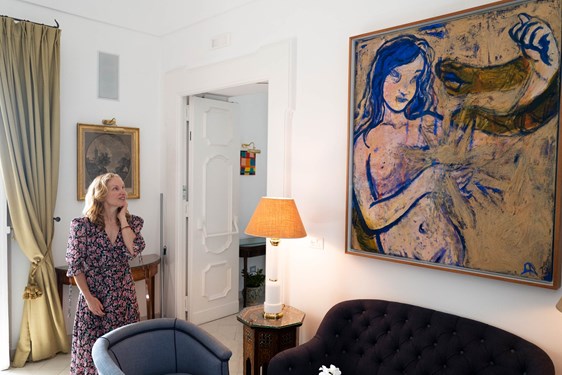
View
LM: Is this a single work?
RA: The two paintings are meant to be one piece. They were made specifically with this room in mind. As they hang across from each other one has the sense of being caught up in their conversation.
LM: Tell me how you chose this room.
RA: When I first visited the hotel in April 2019 I was overwhelmed by its harmony, and the deluge of visual beauty.
LM: It’s the opposite of a white cube, no?
RA: Exactly! I felt it would be a crime to add anything. Then the idea came to me that if I couldn’t add, at least I might be able to replace something. A few years previously, I’d collaborated with chef and restaurateur Daniel Humm to recreate the interior of a famous New York restaurant, Eleven Madison Park, using one of my paintings as the center piece. This was similar, in a way. I found this bar lounge room where there were two existing paintings from the Sersale family collection which curiously were in conversation with each other. On one wall was a portrait of an important Cardinal, a distant ancestor of current hotel owner Antonio Sersale. The Cardinal was much admired by Antonio’s father Franco, who had bought the painting at auction. Needless to say, the idea of replacing these two paintings met some resistance, as Antonio had personal, emotional links to them, but his wife Carla encouraged him and us to make the change.
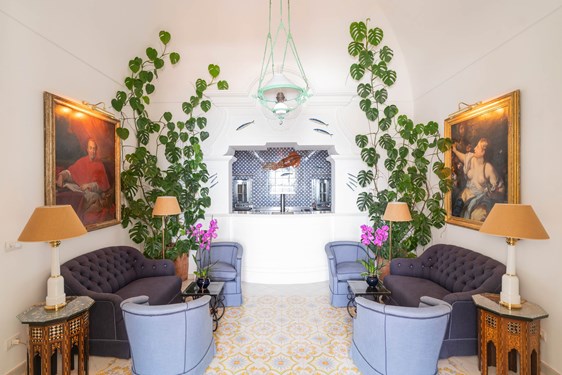
View
LM: There’s something very Neapolitan in that face-off…
RA: Yes! Just as you say it was indeed a Neapolitan face-off...and I wanted to keep this as a priority, to create a work that could channel this ancient historical sensibility. That’s why I dug into my paintings from 1994, a period when my works were telling their own fables, with figures rendered iconographically. I reframed a painting of a girl holding her heart with a snake twisted around her body...then I made a copy of the reframed image but as we know, handmade copies are never perfect. In order to make them less stylistically contemporary, and to resonate with the art of Naples and around – for example Pompeiian frescoes – I set about destroying their surfaces by rubbing their wet oil paint face down into ultramarine blue pigments.
LM: What was the name of the 1994 painting you revisited?
RA: It was called You’re Never Gonna Get Me Motherfucker. 1994. When I made it I was 26 years old, freshly arrived from Hungary, and I saw New York with its glamorous pop decadence as my grand inspiration.
LM: Can you talk about the experience that inspired that 1994 work?
RA: The inspiration was a mix of coming from an Eastern European Catholic background (though this later turned out to be partly Jewish) clashing with the culturally most epic urban melting pot of western culture... I must say I’m still puzzled by the complexities of this clash.
LM: Is this the first time that you’ve worked so closely with a client where the placing of a work is so important?
RA: As I briefly mentioned earlier, I had worked with the master artist chef, Daniel Humm on the centerpiece painting for his Eleven Madison Park restaurant. It is a 12-foot by 9-foot painting entitled Chalkboard Painting IV, EMP in 2017. It was an incredible experience to work with him through the making. He visited the studio often during that time and we became very close friends. He is a great believer, a true inspiration!
LM: Coming back to these two paintings, I love the way that what’s going on hardly seems to fit in the frame, the way it makes you think of what might be outside the frame. This is probably mad, but because these two women are seen only from the waist up, and because they’re so sinuous, and probably also because we’re here at Le Sirenuse, I started wondering if there might be a mermaid’s tail below, rather than legs!
RA: Ha, funny you should ask...no, no mermaid tail has been framed out.
LM: I hate asking artists to explain their work, but can you talk briefly about what she – or these two women – are holding in their hands? You said that in the 1994 painting it was a heart, but here it seems to have the star shape of something that is exploding.
RA: I think it’s maybe best if we leave the freedom of explanation to the viewer. I find it important to give space to the person who is engaged to create his/her very own emotion. I admire artists who are able to preserve the enigma of their works...and artists’ explanations can be quite misleading!
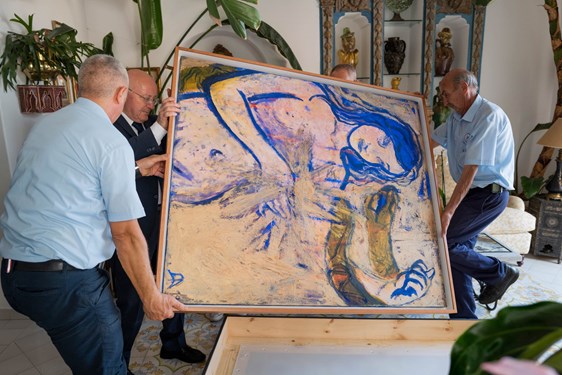
View
LM: What artists do you feel the greatest affinity with?
RA: I go see Van Gogh and Monet at the Met almost every two weeks....and then I generally discover a “new” favourite… but really those two never change.
LM: That gets me thinking, something that comes across in these two paintings of yours as well, that these are both artists where texture is really important…
RA: Texture is the essence of great painting, in my opinion. That’s why it can be an utterly new experience when you see a work direct, not reproduced. Think of Chaim Soutine. His textures are the strokes of a brute, a caveman... when he was painting dead chickens, the meat was rotting in his studio… everything was straight out of the tube. He didn’t have money, then when he had money the war and the Nazis came, he had to live in hiding in the mountains with all sorts of limitation of art supplies.. and yet the paintings rose above his life and circumstances, as if the harder it was, the better he got.
LM: Talking of texture, how did you apply the pigment here? It doesn’t look like much of it is done with a brush…
RA: Sometimes I paint with my fingers, and rub my hands into the surface of the canvas. I’ve been using that style since I was a child. In elementary school I won an art competition with a painting that I painted with my fingers on Styrofoam, and I still like to connect to that 7-year-old state of mind. It was a glorious feeling to be awarded a prize for doing something differently from everybody else. That gave me a direction for the rest of my life.
LM: What was the picture of?
RA: It was Bobita, a dancing fairy from a Hungarian poem.
LM: Fables, myths and fairytales are a big part of your work, no?
RA: Yes, they used to be. They were the sources of my childhood... poems and fables are deeply embedded in my cultural heritage.
LM: Did your parents read fairytales to you, or did you discover them yourself?
RA: My Grandma would recite the Grimm and Andersen tales and some gypsy folk fables, and she also made up stories for us. I still think of those stories, their existential complexity, the morals they taught us and their healing effect. They became the source material from my Eastern European background once I settled in New York and was able to create freely away from restricted views on art and life in general.
I guess the driving force behind all my works is freedom. To move freely between styles and mediums, to be able to push boundaries, to discover a new way to say the old things.
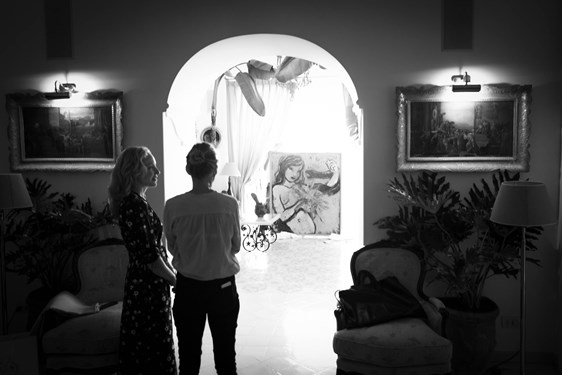
View
Le Sirenuse Newsletter
Stay up to date
Sign up to our newsletter for regular updates on Amalfi Coast stories, events, recipes and glorious sunsets
